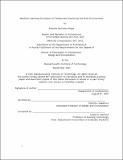| dc.description.abstract | This dissertation explores a new method to model human navigational behavior when engaging with the built environment, with the intent of informing architectural design. A computational process is proposed to produce a generalizable Agent that navigates and explores novel complex environments while interacting with its surroundings.
Current modeling software can effectively simulate pedestrian movement. However, it does not provide other simulations that are critical to the design of architecture such as exploration. Exploratory behavior is especially relevant for architects who seek to predict, to a feasible degree, the interaction between people and newly designed spaces; humans investigating new environments and paths to compelling architectural features. This dissertation demonstrates how machine learning methods identify human exploratory trajectories and map such data to Agent navigational behavior.
Several Machine Learning techniques were applied, including Computer Vision, Bayesian Probability Programming, Density-Based Clustering, and Reinforcement and Imitation Learning. This data-driven method included human trajectory data and three-dimensional site data, collected through fieldwork in Machu Picchu, located in Cusco, Peru. The method had two sections Data Production and Model Development, which resulted in a trained Navigational Agent. Finally, validation tests were proposed and conducted to evaluate the Agent's behavior.
The proposed navigational Agent initially demonstrated generalizable behavior, as when exploring unseen complex environments that it was not trained in. Then, by applying machine learning and analysis of the site-specific data, the human trajectory data was assigned with exploratory intentions of the visitors when approaching compelling architectural features. After the Agent accommodated general behaviors, it demonstrated that site-specific data expanded its behaviors towards simulating human behaviors on the site.
The contributions of this dissertation consist of a pedestrian simulation method, a trained navigational Agent, human trajectory data classification method, human trajectory datasets, three-dimensional site models, and finally, theoretical analysis of a tool that simulate pedestrians’ behavior for architectural design. This dissertation uniquely combined these existing machine learning methods and constitutes an important step in developing computational tools to predict human behavior in architectural space. | |
